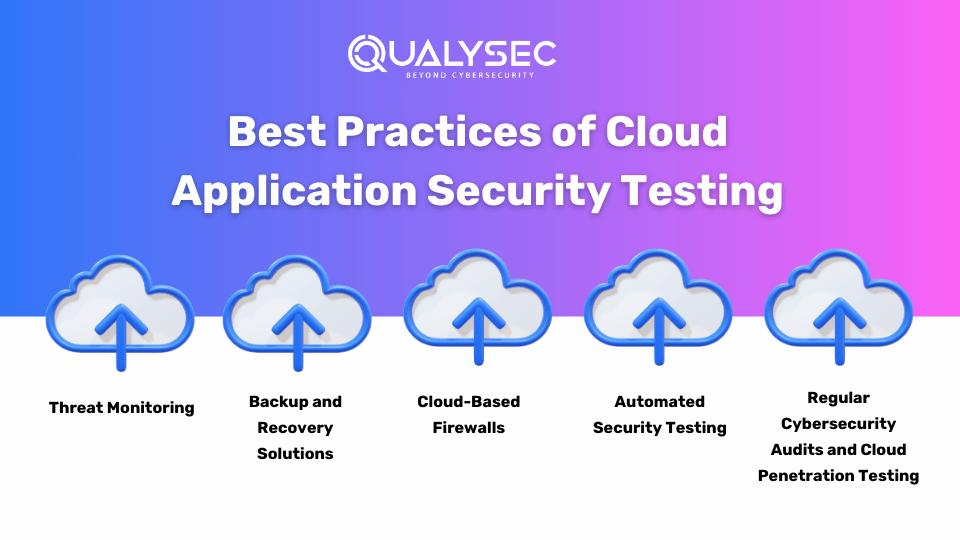Cloud applications now offer businesses a whole new level of scalability and agility. However, despite its ability to run businesses, there are several security risks to worry about. The best way to stay protected against cloud security threats is to incorporate cloud application security testing into your cloud security strategy.
According to Statista, the cloud storage market was valued at 108.69 billion USD in 2023 and is expected to grow to 472.47 billion USD by 20230. This is why 82% of organizations say that cloud security is one of the most important factors in securing their business.
This blog provides an in-depth guide on cloud application security testing, ensuring businesses get the necessary information about creating a secure cloud environment. Let’s explore its importance, techniques, and potential risks associated with cloud applications.
The Definition of Cloud Application Security Testing
Cloud application security testing is a method in which applications operating within cloud environments are tested for security risks and loopholes that hackers could exploit. It is mainly done to ensure that the cloud application and the infrastructure are secure enough to protect an organization’s confidential information.
This type of testing assesses a cloud infrastructure provider’s security policies, controls, and procedures to find potential vulnerabilities that could lead to security risks like data breaches. Typically, cloud application security testing is performed by third-party auditors by collaborating with a cloud infrastructure provider, although the provider may also conduct it internally.
Cloud application security testing uses a wide range of manual and automated testing methods. The data generated through this testing can be used for audits or reviews. Additionally, it offers an in-depth analysis of the risks associated with cloud applications.
Why is Cloud Security Testing Important?
Cloud security testing is important to ensure the safety of your cloud applications and infrastructure. As the market for cloud-based applications grows, the need for application security solutions also increases.
Cloud security testing helps organizations identify potential security vulnerabilities through which massive data theft or service disruption can occur. This can also be a big part of the cloud compliance checklist, as most compliances require timely detection and remediation of vulnerabilities.
Cloud security testing benefits both organizations and cloud security auditors. Organizations use cloud penetration testing to find vulnerabilities that hackers could exploit to compromise cloud applications and infrastructure. In contrast, cloud security auditors use testing reports to verify the security posture of cloud infrastructure.
Understanding Cloud Application Security in Brief
Let’s understand more about cloud applications, the potential risks associated with them, and their security briefly.
Significance of Cloud Applications in Modern Businesses
Cloud applications play an important role in modern businesses because of their numerous advantages. They allow businesses to easily adjust their resources per demand and reduce infrastructure costs. Additionally, cloud applications encourage remote access and increase flexibility by helping employees work from anywhere. The centralized data storage and accessibility of cloud applications enhance collaboration among teams.
Cloud applications are also at the forefront of innovations, as they access advanced technologies like Artificial Intelligence (AI) and Machine Learning (ML) for automation. They also ensure data protection and compliance with regulatory requirements by offering necessary security measures. Furthermore, cloud applications enhance workflow efficiency by enabling seamless integration with other systems.
Overall, integrating cloud applications in modern businesses drives growth and enables adaptability in this digital landscape. This is why cloud security must be strengthened through necessary security measures like cloud application security testing.
Qualysec’s cloud pentest gives you results—no endless emails, no digging through PDFs, no guesswork.

Potential Security Risks Associated with Cloud Applications
Cloud applications offer a range of advantages like flexibility, storage capacity, mobility, improved collaboration, better accessibility, and more. But like any other online applications, they are also prone to various security risks, such as:
1. Data Loss
Data loss or leakage is the most common security risk associated with cloud applications. In the cloud environment, loss occurs when sensitive data is accessed by somebody else, requiring more backup or recovery measures. Data loss also occurs if the data owner cannot access its elements or if the software is not updated on time.
2. Hacked Interfaces and Insecure APIs
As we all know, cloud applications completely depend on the Internet, so protecting external users’ interfaces and APIs is important. APIs are the easiest way to communicate with most cloud services. Also, few services in the cloud can be found in the public domain. Third parties can access these services, making them more vulnerable to hackers.
3. Vendor Lock-In
Vendor lock-in is one of the biggest security risks in the cloud, requiring cloud application security testing. This risk causes organizations to face problems transferring their services from one vendor to another. Moving services within multiple clouds can be challenging as different vendors offer different platforms.
4. Spectre and Meltdown
The risk of specter and meltdown allows programs to view and steal data currently possessed on the system. It can run on personal systems, mobile devices, and the cloud. Your passwords and personal information, such as emails, images, and business documents, will be under threat.
5. Denial of Service (DoS) Attacks
DoS attacks occur when the system receives huge traffic to buffer the server. They mostly target web servers of large organizations, such as media companies, banking sectors, and government organizations. Recovering from a DoS attack requires a great deal of time and money.
6. Account Hijacking
Another major security risk in cloud applications is account hijacking. In this, hackers breach an individual user’s or organization’s cloud account (for example, a bank account, email, or social media account). They use these accounts for unauthorized access and perform fraudulent activities.
7. Insider Threats
Another main threat to cloud applications is insiders. These can be current or former employees of the organization, workers who are negligent in their actions, or attackers who have gained the trust of innocent employees. The risk of insider threats has increased recently, mostly due to the rise of remote workers, policies like Bring Your Own Device (BYOD), or former employees whose jobs were affected by the pandemic.
Best Practices of Cloud Application Security Testing
Organizations need robust security measures during the development and deployment of cloud applications. Here are the best practices to ensure effective cloud application security testing:

1. Threat Monitoring
Continuous real-time monitoring is vital to quickly identify and respond to unusual activities. As cyber threats and data breaches constantly evolve, using threat intelligence data is crucial to staying ahead of malicious attackers. By adopting this effective approach, your cloud security team can quickly detect threats, respond instantly, and reduce the impact of potential cyberattacks.
2. Backup and Recovery Solutions
Implementing backup and recovery is essential to ensure your data is always available and reduce the risk of its loss due to ransomware, accidental deletion, changes, or hardware issues. Organizations can choose different ways for backup, recovery, and archiving.
Using automated backups and lifecycle policies helps keep copies safe, while archives provide a safe space to store used data. Recovery plans help return data during cyber threats by assigning specific roles to people, ensuring the restoration goes smoothly.
3. Cloud-Based Firewalls
Cloud-based firewalls transform traditional firewalls into their cloud-centric versions. These digital guardians are hosted within the cloud and offer a dynamic digital defense system. Their scalability seamlessly matches the evolving needs of both customers and cloud providers, ensuring data remains protected from unauthorized access.
4. Automated Security Testing
Automation allows quick and repeated cloud application security testing, which is crucial in today’s dynamic and digital world, where manual testing is insufficient. Automated security testing provides various benefits, such as increased testing coverage, quicker identification of vulnerabilities, early detection of security issues, and seamless integration of security testing.
5. Regular Cybersecurity Audits and Cloud Penetration Testing
Penetration testing involves a carefully authorized simulated attack by ethical hackers to identify and fix security weaknesses. Its purpose is to assess the strength of the security measures within your cloud applications and to mitigate any vulnerabilities and loopholes detected.
Regular cybersecurity audits, mandated by regulatory bodies, are essential to ensure compliance and security. They play a vital role in verifying the effectiveness of your existing cloud security measures, including those set up by your cloud service provider.
Want to see a real Cloud App Penetration Testing Report? Click the link below and download one right now!
Latest Penetration Testing Report

Key Components of Cloud Application Security Architecture
A cloud application security architecture consists of a wide range of services that protect the cloud environment’s data, application, and infrastructure. It is designed to offer a secure platform where critical business operations can be executed without the risk of unauthorized access or data loss.
Here are the Key components of Cloud Application Security Architecture:
1. Vulnerability Scanning and Compliance
Cloud environments should be continuously monitored to detect potential vulnerabilities. Vulnerability scanning is a cloud application security testing method that identifies and classifies system weaknesses in cloud-based applications, predicting the effectiveness of preventive measures. It’s important to understand how to interpret the results and prepare for the scan to get the most out of the reports.
The demand for vulnerability scanning is increasing, with reports often requested for compliance purposes, especially when dealing with larger clients. Suppliers are frequently asked to confirm whether they conduct scans for their cloud environment. Compliance scans also adhere to specific frameworks such as PCI DSS, HIPAA, GDPR, etc.
2. Network and Firewall Security
With a growing number of remote workers, securing your systems from unauthorized access is vital. Here are some methods:
- Firewalls: Controls network traffic by blocking and allowing based on type, IP, and Port.
- Packet Filtering/Inspection: Stop network traffic based on the content of requests.
- Deep Packet Inspection Firewalls: Analyze packet data and can detect application layer attacks.
- Network Zone Design: Using private and public zones to enhance security.
3. Edge Network Protection
Enhance perimeter security by integrating next-gen firewalls with advanced rule-based access controls and comprehensive reporting, as well as adhering to client access through encrypted tunnels (VPN). Edge network protection has a few components, such as:
- Geo-based protection and content filtering
- Threat detection and mitigation (IDS/IPS) services
- Domain Name System (DNS) services
4. Web Application Firewalls
A Web Application Firewall (WAF) monitors, filters, and blocks HTTP traffic to and from a web application. Cloud providers like AWS and Azure offer rule-based protection through their respective WAF services.
Geo-location blocking can be integrated into the WAF design and modes, including Protection (Blocking) and Detection (Matching), for flexibility in security configuration.
5. OS Vulnerability Protection
Implementing necessary cloud application security testing measures is important to protect your operating system (OS) from various threats. Some effective OS vulnerability protection methods include:
- Operating System Hardening
- Regular Automated Patching
- Security Update
- Emergency patching
6. Security Information and Event Management (SIEM)
The combination of Information and Event Management delivers real-time analysis of security alerts and typically includes:
- Event Log Centralized
- Collection and Reporting
- Anomaly Scoring
- Alerting
- Mitigation
7. Threat Protection Layers
The idea behind threat protection is implementing a network security strategy with multiple layers of security measures. Each defense component has a backup, which has a better chance of stopping invaders than a single solution.
Some examples of layers include:
- Patch management, including Virtual Patching
- Anti-virus software
- Anti-spam filters
- Digital certificates
- Privacy controls
- Data encryption
- Firewalls
- Vulnerability assessment
- Web protection
8. Application Code Vulnerabilities
Applications, especially those designed for cloud environments, serve as gateways to servers and networks. These cloud applications often become prime targets for malicious actors who are constantly improving their methods to penetrate software. Therefore, cloud application security testing should be an ongoing activity for strong security. With best practices for application security, you can identify vulnerabilities before attackers exploit them to breach networks and data.
9. Machine Learning (ML) Vulnerabilities:
Malicious attacks on data or models can disrupt or fail ML systems, making them vulnerable to direct data corruption, such as data poisoning and evasion attacks.
Data poisoning involves incorporating or altering training data to cause incorrect predictions, fixed by various data protection strategies.
Data evasion sends invisible data changes to an ML endpoint to invoke misclassification, requiring the protection of model details.
ML models can also be targeted, with algorithms leaked and manipulated or sensitive model information requiring techniques to detect and prevent malicious behavior.
Human validation is necessary for system design and operation so that potential human error or malicious actions can be recognized.
Regular review and third-party security assessments are vital for a comprehensive defense against evolving threats in your cloud application security testing plan.
Talk to our Cybersecurity Expert to discuss your specific needs and how we can help your business.
Conclusion
Organizations must remember the importance of cloud application security testing and cloud security testing to secure their businesses. Security should be a top priority to protect confidential information and prevent cyberattacks. Organizations can stay one step ahead of potential threats by regularly updating security measures and testing their cloud-based applications. To ensure maximum protection, it is essential to keep up with the latest trends and technologies in cloud application development and testing security.
With the ever-evolving landscape of cyber threats and security, staying up to date is key to securing valuable digital assets and maintaining trust with customers. Therefore, organizations must invest time and resources into proper security measures to reduce risks and maintain a secure environment for their cloud applications.
FAQs
Q: What is cloud security testing?
A: Cloud security testing is a method of testing cloud applications and other infrastructure for security risks that hackers could exploit. Cloud security testing ensures that your cloud security protects an organization’s sensitive information.
Q: Do cloud service providers allow cloud security testing?
A: Third-party auditors with a cloud infrastructure provider usually perform cloud application security testing. However, the cloud service provider can perform it using manual and automated testing methods.
Q: How many times you should perform cloud application security testing?
A: The frequency of cloud application security testing depends on various factors, such as the application’s complexity, risk level, and regulatory requirements. It is recommended that organizations conduct regular security testing for their cloud-based applications at least once a year, especially after significant changes to the application.
Q: What are the benefits of cloud application security testing?
A: With cloud application security testing, organizations can quickly detect and mitigate security vulnerabilities, improve compliance with industry standards and regulations, reduce the risk of data breaches, and enhance the overall security measures of cloud-based applications.
































































































































































































































































































































































































































































































































0 Comments